I-STEM Multidisciplinary Summer Program Exposes UHS Athletes to Different STEM Departments/Units
September 12, 2017
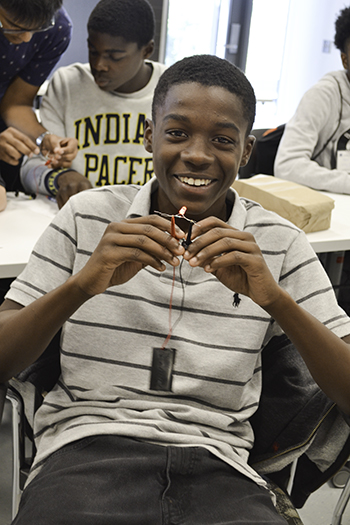
A UHS student proudly exhibits the glowing LED light during a hands-on activity on ECE Day.
From August 7–18, twenty-seven Urbana High School (UHS) athletes, mostly underrepresented minorities, participated in the first-ever I-STEM Summer Camp. The goals of this multidisciplinary summer program were to 1) expose participants to various STEM fields so they know what their options are when choosing their career/ college path; 2) to build teamwork and lab skills in different STEM disciplines; and 3) to allow students to experience what STEM research is about. Ten different STEM departments and units on campus were each responsible for one day of activities during the two-week camp.
According to I-STEM Interim Director Luisa Rosu, the long-term goal of the program is to build a foundation for a stronger STEM partnership between the campus and local schools with the potential to support the pipeline for future research capacity in the participating departments. Of particular emphasis in the partnership is underrepresented groups in STEM.
Rosu shares why the program is important: "Students, high school students in particular, are looking for college experiences. They need this kind of experience, to come on our campus, to see what it means to be a student, to see what it means to stay in a class for a longer time—not just for a couple of hours, not just for a lab visit, but an entire college day experience over two weeks."
Multi-Disciplinary STEM Activities
Each day of the camp addressed a different STEM discipline. Faculty, students, and other personnel from ten different Illinois departments, units, or groups participated in the camp. Following are key personnel who presented, plus a brief description of the types of instruction and/or hands-on activities to which they exposed the students:

A camper uses a pippette to remove some DNA during one of the MCBees' hands-on activities related to the extraction of DNA.
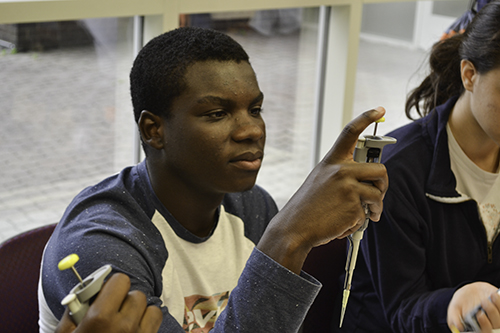
A UHS athlete practices using a pippette during MCB Day.
MCBees. On Monday, August 7th, members of the MCB (School of Molecular and Cellular Biology) graduate student organization used a fun scenario, a crime scene involving a "dead graduate student," to structure their activities. For the “Whodunit?” students were to discover which of two suspects did it: an undergrad who wanted the grad student’s spot and/or funding, or the professor who was upset with the grad student because he wasn't working hard in the lab.
The job of the high schoolers was to take DNA samples from the crime scene, extract DNA from the cells found there, then perform a Polymerase Chain Reaction to amplify the part of the DNA that they were interested in, producing millions of copies of that DNA. Then they were to take that DNA and separate it on a gel, a thick jello-like substance that they could run the DNA through. Based on size, a different pattern would appear, that they would then need to match to the pattern found on the murder weapon.
The reason the MCBees chose this experiment, explains MCBees Outreach Coordinator Mara Livesey, is because it was a real research experience. “It's like a real, start-to-finish experiment, and a lot of the techniques we use today are things that I use in lab every day.”
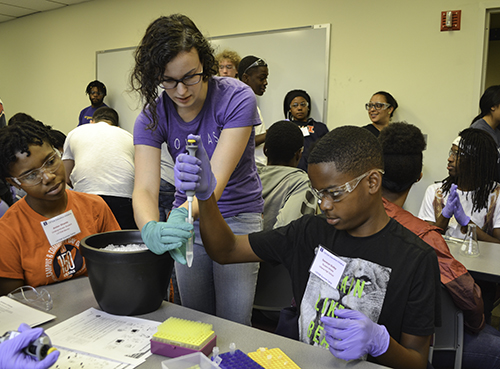
Mara Livesey (center), coaches a student who is using a pippette to obtain a sample from a test tube.
“I think something like this where we can make a fun scenario for the kids to follow along with is more interesting. It can maybe grab their excitement a little bit more and motivate them to maybe consider science in their future. I want them to have a real experience, like this is really what we do every day in lab. And if they can understand that, then maybe they'll be interested, hopefully.”
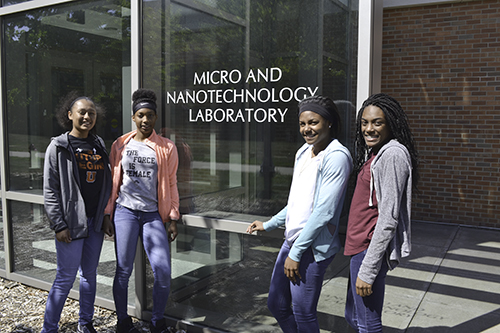
Four UHS athletes outside of the MNTL.
MNTL/Nano@IL RET. On Tuesday, August 8, MNTL Day, I-STEM campers visited MNTL (the Micro and Nanotechnology Lab), for “A Primer on Semiconductors.” In preparation for creating their own poster about their I-STEM camp experience, students listened to nano@illinois RET teachers’ poster presentations about their research this past summer. In addition, students used a rubric to evaluate each teacher’s presentation according to the following four criteria: organization, use of graphics, effectiveness, and responsiveness, giving each a grade from 1 to 3. In the afternoon, Dr. Mark McCollum led students on a tour of MNTL’s cleanroom laboratory.
One Nano@Illinois RET participant, J. D. Graham, who teaches biological sciences to grades 9-12 at Sullivan High School in Sullivan, Illinois, shares why the I-STEM camp was a good experience for the UHS students.
"It's just exposure," Graham acknowledges. "It's like learning another language; it's like going to another country. You can hear that those things exist, but to actually see somebody speak a language, it takes the mystery away that it's not something somebody else does, it's something you can do."
Civil and Environmental Engineering (CEE). CEE Assistant Professor Ange-Therese Akono, along with some students in her lab, exposed the high-schoolers to a nanomechanics workshop on Wednesday, August 9.
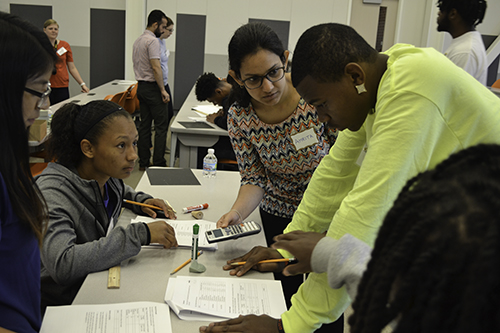 A CEE graduate student (center) works with I-STEM campers during an activity measuring indentations on materials.
A CEE graduate student (center) works with I-STEM campers during an activity measuring indentations on materials.Students performed indentation tests on various materials; did a polishing activity similar to what Akono’s students do prior to testing materials, built bridges with popsicle sticks, and in the afternoon, took a tour of the Newmark Lab’s Crane Bay.
According to Akono, events like this help high school students “just get excited about science!"
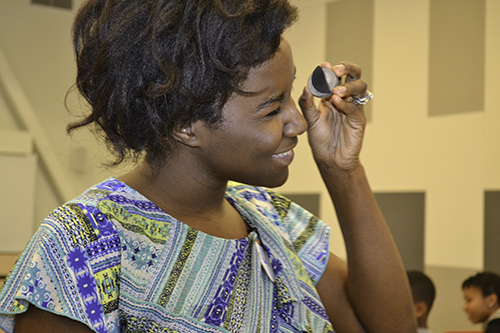 CEE Assistant Professor Ange-Therese Akono examines a specimen a student has polished to see if it needs additional polishing.
CEE Assistant Professor Ange-Therese Akono examines a specimen a student has polished to see if it needs additional polishing."They get to discover an aspect of science they wouldn't have thought about," she continues. "In this case we're looking at civil engineering. They get to understand what it is to be a civil engineer, what kind of questions we're asking, and how this is both exciting but also applicable in real life.” Akono asserts that students experience civil engineering every day, “but maybe they’ve never thought about all the people actually designing it.” She says their other goal was “to inspire them so that later, they would select these careers and be the future engineers that we need for this country.”
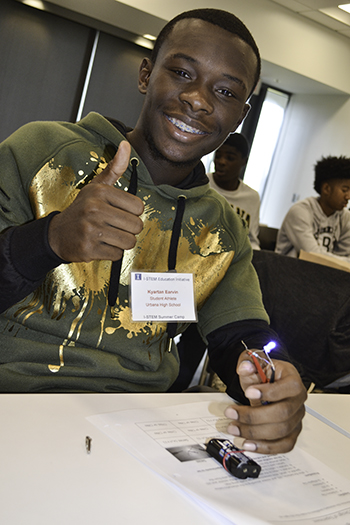
A camper gets his LED light to light up during a hands-on activity on ECE Day.
Electrical and Computer Engineering (ECE). On Thursday, August 10, ECE Day, Lynford Goddard and his students taught the campers about how to design research experiments, how to solder, then had them build a circuit.
One of the graduate students from his lab, Lonna Edwards, who was involved in four camps this past summer, indicates that she participates in outreach events like I-STEM’s camp because it’s something she didn’t have access to at that age.
“I love doing outreach. It's something I wish that I’d had when I was younger. I wasn't aware. I didn't know what an engineer was until I was starting college, and I learned about what they do, so I just picked it as a major, not really knowing much about it. It was a struggle in the sense that I had to maintain a certain GPA, so I was stressed out a lot of the time. But I made it, so I made it a goal to expose people earlier.”
Edwards says it’s a good idea to bring high school kids into a lab early. “The earlier the better,” she says. “But kids who get to experience this are at an advantage, because they're learning about things I didn't learn until I got to college. I tell them not to feel bad if they feel like they're not getting something, I tell them that they're still ahead of the game.”
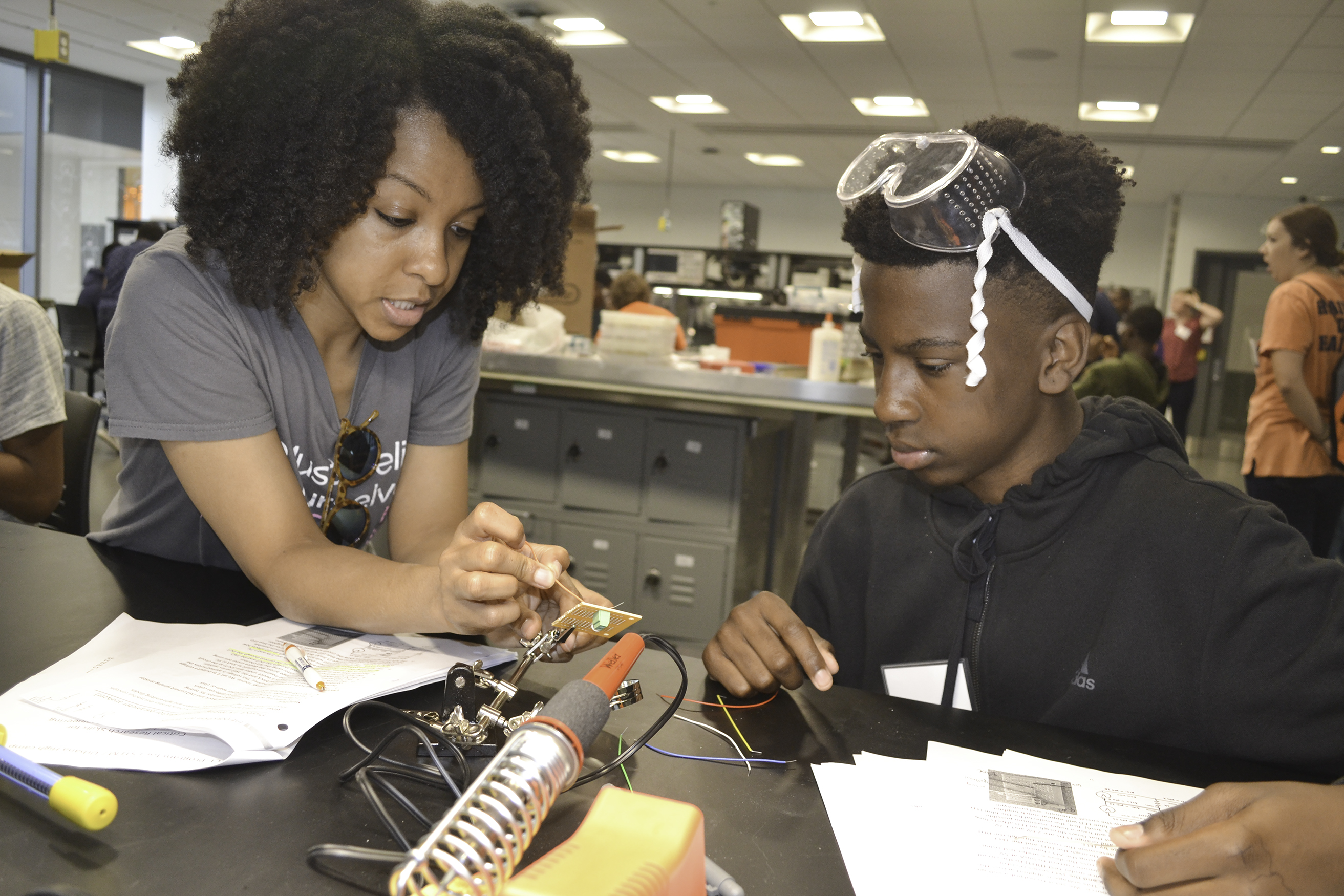 Lonna Edwards, an ECE grad student, helps a camper build a circuit
Lonna Edwards, an ECE grad student, helps a camper build a circuit“The earlier you get exposed, the better you'll be at it," she adds, "because it won't be as stressful, and because it's something you've seen before. You'll be able to learn it and be confident. So I wanted to reach out to kids who are younger so they get that exposure, especially kids that are under-represented in the field.”
Mathematics. On Friday, August 11, Mathematics Department Head, Matt Ando, welcomed the students and discussed the importance of math. Later, Assistant Professor Phillip Hieronymi introduced students to mathematical logic via a “brain teaser” about Alan Turing. In addition, several math Ph.D. students, Alexi Taylor Block Gorman, Colleen Elizabeth Robichaux, Elizabeth Field, and Vanessa Rivera-Quinones, led the highschoolers in hands-on activities related to their math research.
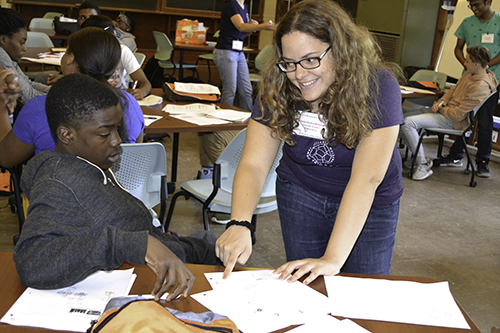 Vanessa Rivera-Quinones interacts with a UHS student during Math Day.
Vanessa Rivera-Quinones interacts with a UHS student during Math Day.For instance, Vanessa Rivera-Quinones, a fifth year math Ph.D. student, did a fun event with the students related to disease modeling. In her research, she uses mathematical models to try to understand how disease spreads, in particular in a lake ecosystem.
Rivera-Quinones participated in I-STEM’s camp because she believes “math should be painted in a fun light.” While she says the math in school is interesting, she admits, “It doesn't tell you the complete picture. I always want try to motivate other students to see how math is used in non-traditional settings or how the math in high school could be pushed to explain some real-life phenomenon.”
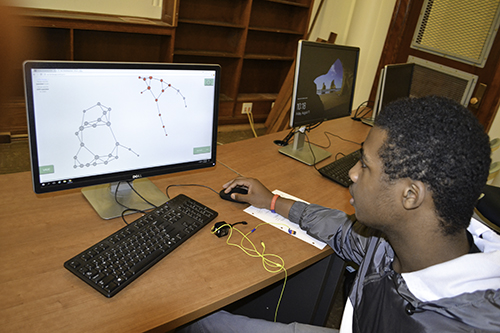 While playing VAX, UHS athlete Sergio McClain has successfully isolated the persons with the disease (the red dots) to stop the spread of the disease.
While playing VAX, UHS athlete Sergio McClain has successfully isolated the persons with the disease (the red dots) to stop the spread of the disease.So, she gave the students an exciting exercise related to real life and to her work in epidemiology (the spread of infectious diseases). In a website game, called VAX, students were given a limited number of “quarantines” (breaking a link from one person to another) to try to stop a disease from spreading. Once the disease got started, however, it spread rapidly from person to person. The students were quite engaged as they scrambled to try stop the spread of the disease—with varying degrees of success.
Regarding the impact I-STEM’s camp had on the students, Rivera-Quinones reports, “Since this program is trying to paint the picture of what a researcher looks like, hopefully they can see that it's not just one picture; across different disciplines, we do different types of things, and all of them are research.”
According to Rivera-Quinones, her main goal was for the students to gain confidence: “My hope for them is that they understand that there's not one definition of being a mathematician,” she explains. “They can also be mathematicians even though they're not pursuing a PhD in math. As long as they have interest in how things work and how patterns are formed, they can also be mathematicians.”
Aerospace Engineering. On Monday, August 14, I-STEM campers learned a bit about the engineering and physics behind how airplanes and rockets fly courtesy of the Illini Aerospace Outreach, Aerospace Engineering's student organization, who organized the event. The high schoolers learned about flight mechanics and jet engines, got a demonstration of the wind tunnel, learned rocketry basics, then designed, built, and got to launch balsa wood gliders and model rockets they built.

During a tour of the Aerospace Engineering Department, I-STEM campers and mentors view a Rolls Royce rocket engine housed in basement of Talbot Lab.
Elle Wroblewski, an Aerospace Ph.D. student who helped with the camp shares why events like the camp are important for high school students.
“When I was in high school,” she explains, “my impression of engineering was only based off of what older people would tell me; I didn't have any first-hand experiences as to what that meant. An event like this shows students more in depth and gives them a better grasp as to what engineering is and shows them a practical application in math and science, whereas beforehand, I feel like it's a little more theoretical, or it's a bit more science fiction based."
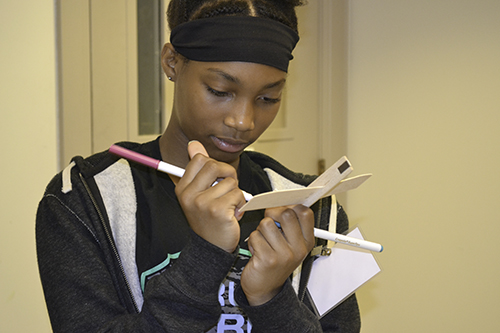
An I-STEM camper making a balsa wood glider during Aerospace Day.
In fact, Wroblewski says that much of what kids believe about space flight is based on what they’ve seen in movies and on TV and “not so much on the technical details,” she admits. “An event like this makes it more realistic, so that when they're thinking about careers, they have a better grasp as to what it actually is.”
More importantly, Wroblewski says these types of events show them that they have what it takes to be engineers, refuting “pre-conceived notions like ‘I can't do that because I'm not smart enough,’ because they've experienced that they are smart enough to do it. It's exciting and fun that they can achieve something as opposed to not knowing whether or not they could.”
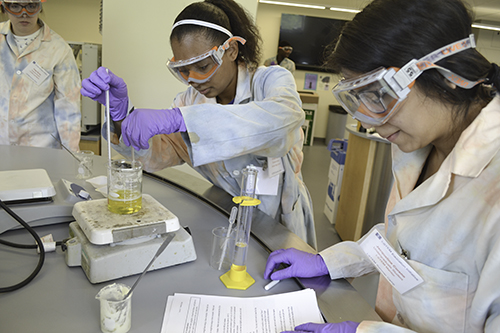
A UHS student (center), stirs the contents of a beaker doing during a chemistry hands-on activity.
Chemistry. On Tuesday, August 15, Chemistry’s Tina Huang, and her lab assistant, Stephanie Legare, helped campers learn about chemistry via several hands-on activities. After learning about lab safety, students suited up in lab coats, goggles, and gloves then did activities in saponification (making soap), forensic chemistry (extracting pen ink and candy dye using chromatography), and how temperature can change the physical and chemical properties of matter.
According to Huang, activities like I-STEM camp’s Chemistry Day are important to help students overcome their fear of certain STEM subjects:

Tina Huang (right), helps a UHS student doing a hands-on activity during I-STEM Camp's Chemistry Day.
“We hear from the students that in order for them to get interested, they need to start as early as possible,” Huang explains. “Many students have a fear of STEM. Even though they want to major in it, they're sometimes afraid when they get to the college level. They view certain topics as really hard and difficult to master. I think if we get the attitude out and give them something fun that they can do, that they’ll know it's not impossible and that learning also takes time. So then, we can have that attitude when they get to college that it's going to be hard, but it's not impossible.”
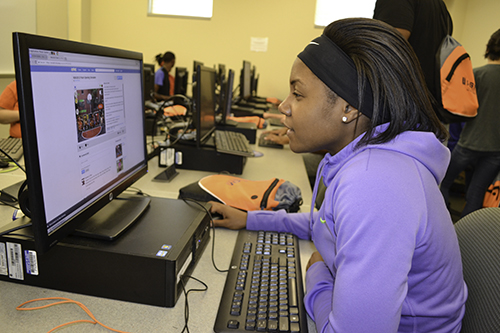
An I-STEM camper working on her Scratch project.
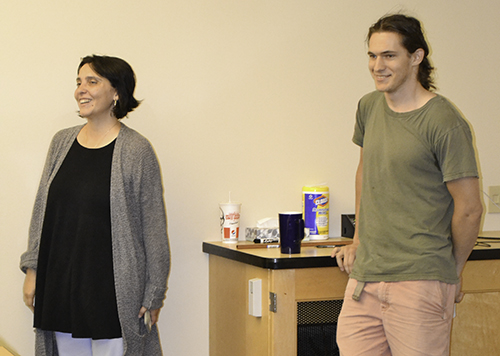
I-STEM Interim Director Luisa Rosu introduces CS PhD student Everett Hildenbrandt, who shared a magnet/copper activity with the campers.
Computer Science (CS). On Wednesday, August 16, students learned about Computer Science and coding. After a presentation by I-STEM camp mentor and ECE major Kushal Goenka about what it means to code, students visited a CS computer lab and made Scratch (an online program for programming stories, games, and animations) projects of their own. Students also heard from a CS PhD student, Everett Hildenbrandt about CS formal methods, did a Magnet/Copper activity, and learned that computer science is everywhere.
Mechanical Science and Engineering (MechSE). On Thursday, August 17, a team of professors and students from MechSE, including Elif Ertekin, Mariana Kersh, Kazem Alidoost, Jason Kim, and John Shanley, exposed the campers to some current research in their field. The hands-on activity they did involved making a prosthetic device: an arm for an amputee that operated using pressurized air from an air tank and included a hand with fingers that could pick up a pair of sunglasses.

Elif Ertekin watches as an UHS student works on his team's prosthetic during the I-STEM Camp's MechSE Day.
According to Assistant Professor Elif Ertekin, one of their goals was to help the high school students see themselves doing engineering.
“A lot of the modern research shows that in order to be able to choose a certain career path, you have to be able to envision yourself being that person and doing that job in the future. So right now, by trying to give the young people hands-on experience, working directly with graduate student researchers and faculty, I think that really helps them imagine themselves doing this as a part of their careers in the future.”
MechSE’s Mariana Kersh says events like the camp are important to high school students to “kind of provide that sort of light at the end of the tunnel” and to help them “learn that there is this bigger picture.”
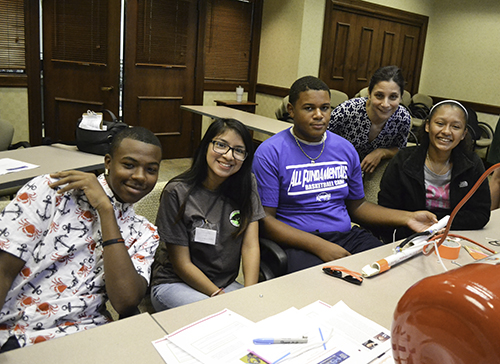
Ertekin poses with the team that won the Prosthetic Device competition.
While high school students “may know that they're good in math or that they like science… they don't really know where that's going to take them.” She envisions the event as helping to show them the possible routes early, and help keep them on track. She admits that students need to have a vision. She explains that “It's not about the degree per se, it's about what you're going to do with it in order to help” that can help them to get through the distractions and getting discouraged when they don't do well on a test, because they’ve learned that “there’s this bigger picture that I really learned about and that's what is driving me.”
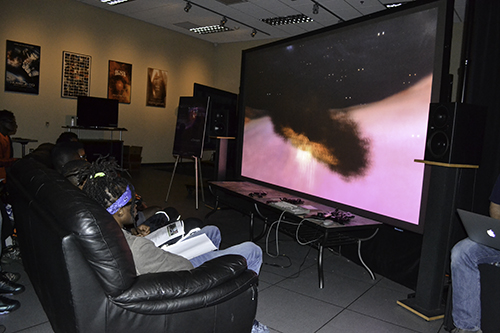
UHS students enjoying one of the AVL's 3D presentations.
National Center for Supercomputing Applications (NCSA):
On Friday, August 18, campers learned about research going on at NCSA, including a peek at some of the Advanced Visualization Laboratory’s (AVL's) high-resolution, cinematic-quality data visualizations for public outreach. Students also attended a panel featuring AVL research programmer Kalina Borkiewicz; Eliu Huerta, a Physics and Astronomy Research Scientist in the Relativity Group; Dan Lapine from the Scientific Computing Services Group; and Adam Slagell of NCSA’s Cybersecurity Group. Finally, students toured the National Petascale Computing Facility, home of the Blue Waters Super Computer.
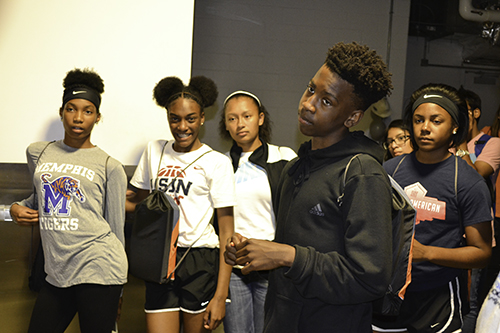
UHS students during a tour of the National Petascale Computing Facility.
Barbara Jewett, a managing editor at NCSA, shares why events like I-STEM’s camp are important: “Because you never know what is going to change someone’s life. And it is very important that we encourage young people to explore careers and the other opportunities that are available to them in the areas of math and science. And by exposing them to what is available on campus, we can stimulate their interest.”
As an example, Jewitt shares an anecdote about her daughter, a chemistry Ph.D. student. “She got her interest in chemistry from freshman chemistry the very first day,” Jewett explains, “when the instructor poured two solutions together, and they turned pink!”
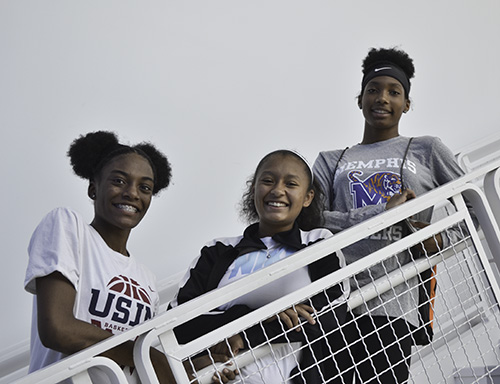
Three female UHS athletes enjoy the Tour of Blue Waters at the National Petascale Computing Facility.
“You just never know,” she continues. “There are so many opportunities and things you can do with science. Plus, let’s face it, science affects our daily lives. All the food we eat; all the products we use; the air we breathe; the science that grows things. So science is in everything. So just the exposure to it and getting people involved in science is really important.”
Learning Opportunities for Developing Soft Skills
Besides exposing under-represented minority HS student-athletes to various STEM research experiences and helping them to make informed decisions when choosing their career/college path, this pioneering multidisciplinary program also offered learning opportunities for developing soft skills, like teamwork, communication, assertiveness, and adaptability.
UHS students worked in groups, under ISTEM mentors’ supervision, to incorporate their two-week experience into a poster activity. Students were given the assignment to make the connection between the best experience they had during the camp and their current career choice. As a final culminating event, at some point in fall, UHS will hold a poster event where students will present about their ISTEM summer experiences to their UHS colleagues and teachers.
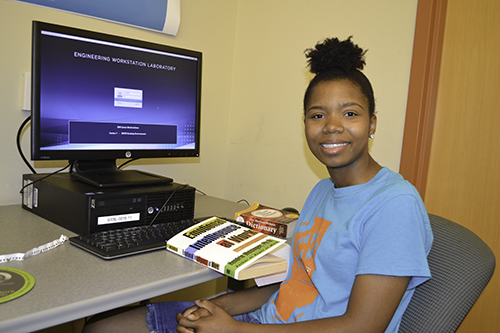
I-STEM camp mentor, Amber Shields.
Mentors. Part of the conceptualization, planning, and organizing of the program, and in addition to exposure to more than 100s Illinois faculty, students and other personnel from the participating departments, units, or organizations, I-STEM incorporated an additional component: Illinois students served as mentors to the high schoolers. These mentors not only helped to guide and motivate students during activities, but provided the opportunity for relationship-building with Illinois students. The idea was that the campers might more easily identify with the Illinois undergrads because they were closer in age to the high school students, plus they had recently been through the college/career decision-making process themselves.
Regarding the camp's impact on the high schoolers, one of I-STEM’s mentors, Amber Shields, a junior in Human Development and Family Studies, reports,"My group has been very engaged...Someone wants to be an engineer, so he's asking a lot of questions...I like the experience they're getting. I like to see their happy faces; I like to see them engaged, asking me questions."
Shield's mentees weren't the only ones benefitting from the camp. In addition to mentoring her students, Sheilds was jumping in with both feet during the various multi-disciplinary activities. "I'd like to thank you for me," says Shields, "because I learned a lot of things throughout this camp. I learned new buildings that I've never seen before, never gone inside before because some buildings are restricted. You have to be an engineer or a STEM student to get inside them. It's a very new experience, and it's very appreciated. I learned something new."
The mentor leader, Kadeem Fuller, shares that he got involved with the camp in order to get to know kids. “Having the time to engage with students that are younger than me, people that only a couple years ago, I was in their shoes,” he admits. “So anytime I can give them a type of guidance or something to do other than just sitting at home during the summer time.”
Kadeem adds that one reason he hopes to get to know the kids, is so he can get to know what they want to do, “get to know their passion, so we can kind of push them in the direction that they want to do and what they want to be.”
I-STEM Interim Director Luisa Rosu believes the camp had just such an impact on the students: it gave them confidence to consider a career in STEM:
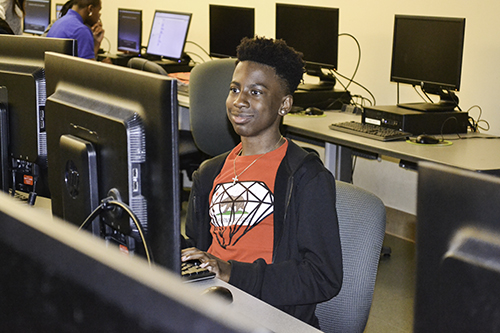
An I-STEM camper enjoys using Scratch during the camp's Computer Science Day.
"I would say the biggest impact is that students became aware of their potential. Most of the students attended our Health Day in spring. I remember that first hour when they entered the IGB conference room, you could see in their eyes, it was like, 'This is not my place. Why am I here? Why did they bring me here? What's this about?' And during that day in spring, they started to feel more comfortable. The first day of our summer camp program, we started with the MCBees, a familiar experience and familiar faces, and it clearly gave students this comfortable feeling. 'I can be a college student. I have this potential; it's just up to me what I choose.' And I think this is the best thing about that first day of their summer program experience—it was a shift from just being comfortable with college to starting to think, ‘Which STEM discipline do I like the most?’”
Author/Photographer: Elizabeth Innes, Communications Specialist, I-STEM Education Initiative
More: 8-12 Outreach, Aerospace Engineering, Chemistry, Civil Engineering, Computer Science, ECE, I-STEM Initiatives, Math, MCB, MCBees, MechSE, MNTL, Nano@illinois, STEM Pipeline, Summer Camp, Underserved Students/Minorities in STEM, Urbana High School, 2017
For additional articles about I-STEM's 2017 Summer Camp, see:
- MCBees Use “Whodunit?” to Pique UHS Students’ Interest in Science During I-STEM Summer Camp
- MNTL Day Exposes UHS Students to Nanotechnology Research During I-STEM’s Summer Multidisciplinary Camp
- Akono and Company Teach UHS Students About Civil Engineering and Strength of Materials During I-STEM’s Multidisciplinary Summer Camp
- ECE Day at I-STEM’s Multidisciplinary Summer Camp: Soldering, Circuits, and Software
- Math Day at I-STEM’s Multidisciplinary Summer Camp Adds Up to Fun
- During I-STEM Summer Camp, Urbana High School Students’ Understanding of Aerospace Engineering Soars
- UHS Students Explore Computer Science, Coding, During I-STEM Camp’s CS Day
- At I-STEM's Multidisciplinary Summer Camp, UHS Students Have Fun with Chemistry—Everything From Soap Making To Glow Sticks to Ice Cream
- UHS Students Gear Up for Mechanical Science and Engineering During I-STEM Summer Camp
- During I-STEM Camp’s NCSA Day, UHS Students Experience Data Visualization, Super Computers, and NCSA’s Research
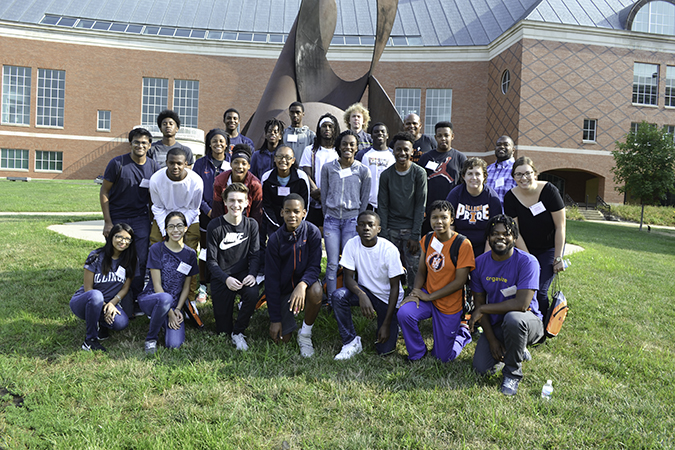 I-STEM Summer Camp participants, mentors, and leaders.
I-STEM Summer Camp participants, mentors, and leaders.













.jpg)
















